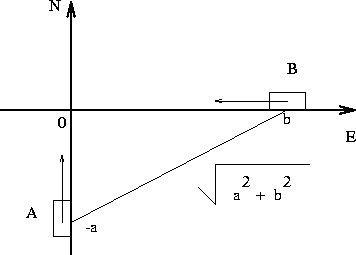Problem 1:The radius of a right circular cylinder is decreasing at a rate of 1.2 cm/s while its height is increasing at a rate of 3 cm/s. At what rate is the volume of the cylinder changing when the radius is 80 cm and theight is 150 cm?Solution:Let, V,r and h denote the volume radius and hight of the cylinder, then |
> V := Pi*r^2*h;
2
V := Pi r h
| From the Chain rule formula we have: |
> Answer1 := 'diff(V,r)'*'diff(r,t)' + 'diff(V,h)'*'diff(h,t)';
/ d \ / d \ / d \ / d \
Answer1 := |---- V| |---- r| + |---- V| |---- h|
\ dr / \ dt / \ dh / \ dt /
| and replacing V and the given rates, |
> answer1 := diff(V,r)*(-1.2*cm/s) + diff(V,h)*(3*cm/s);
2
Pi r h cm Pi r cm
answer1 := - 2.4 --------- + 3 --------
s s
3
Pi cm
answ1 := - 9600.0 ------
s
3
cm
ans1 := - 30159.28948 ---
s
Problem 2:Car A is traveling north on Highway 16 at 90 km/h. Car B is traveling west on Highway 83 at 80 km/h. Each car is approaching the intersection of these highways. How fast is the distance between the cars changing when car A is 0.3 km from the intersection and car B is 0.4 km from intersection ?Solution 2:The following figure depicts the information given in the problem. |

| Let us call R the distance between the two cars at an arbitrary time t, when car A is at a distance "a" from the intersection (the origin in the picture) and car B is at a distance "b" from the intersection. To compute the speed at which R is shrinking we need to compute the derivative of R w.r.t. time. The chain rule gives, |
> #
d / d \ / d \ / d \ / d \
---- R = |---- R| |---- a| + |---- R| |---- b|
dt \ da / \ dt / \ db / \ dt /
| R depends on "a" and "b" as it is shown in the figure above and the distances and speeds are given in the statement of the problem, thus, |
> R:=sqrt(a^2+b^2);a0:=0.3*km;b0:=0.4*km;da2dt:=-90*km/h;db2dt:=-80*km/h;
2 2 1/2
R := (a + b )
a0 := .3 km
b0 := .4 km
km
da2dt := - 90 ----
h
km
db2dt := - 80 ----
h
| Notice the negative signs in front of the speeds for A and B. This is because the distances to the intersection are shrinking. Replacing into the formula for the chain rule we get, |
> ex1 := diff(R,a)*da2dt + diff(R,b)*db2dt;
a km b km
ex1 := - 90 -------------- - 80 --------------
2 2 1/2 2 2 1/2
(a + b ) h (a + b ) h
csgn(km) km
answer2 := - 118. -----------
h
| as usual maple is overly careful about "km" and just in case "km" stands for a complex number with negative square it uses the csgn (complex sign function). We know that "km" stands for kilometers which is REAL and non negative so we can disregard the csgn(km) as 1. If we let maple know that "km" is non negative then it will make the pesky csgn dissapear. Look: |
> assume(km > 0): answer2;
km~
- 118. ---
h